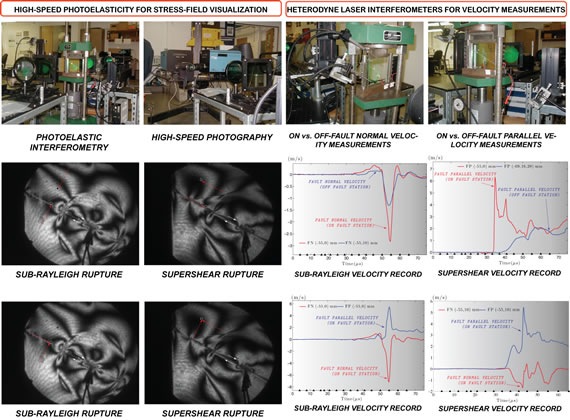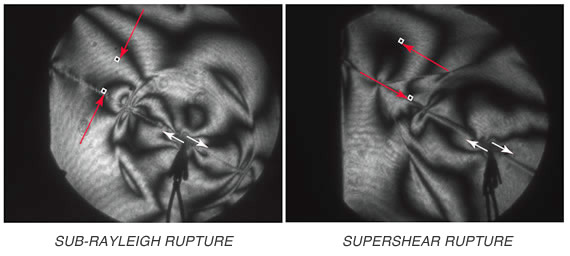

| Theodore von Kármán Professor of Aeronautics and Mechanical Engineering |
Research Interests Laboratory Earthquakes 1: Rupture Speeds, Modes, Inhomogeneous Faults, Directionality
Collaborators:H. Kanamori and N. Lapusta, Caltech; J. R. Rice, Harvard; M. Bouchon, Grenoble, France; S. Das, Oxford, UK. Students/Post Docs: Michael Mello and Harsha S. Bhat, Caltech The goal of the this work is to create model laboratory experiments mimicking the dynamic shear rupture process associated with natural earthquakes. Such experiments are used to observe new physical phenomena and to also create benchmark comparisons with existing analytical analysis and field observations. The experiments use high-speed photography, photoelasticity, and laser velocimetry as diagnostics. The fault systems are simulated using two photoelastic plates (Homalite) held together by friction. The far field tectonic loading is simulated by pre-compression and the triggering of dynamic rupture (spontaneous nucleation) is achieved by suddenly dropping the normal stress in a small region by disintegrating a thin wire. The fault forms an acute angle with the compression axis to provide the shear driving force necessary for continued rupturing. We investigate the characteristics of rupture, such as rupture speed, rupture mode, associated ground motion under various conditions such as tectonic load and interface roughness. Both homogeneous and bimaterial interfaces (abutted by both elastic and damaged medium) are investigated.
Review Papers:
Some of the key outcomes from this project are: 1) First laboratory evidence for supershear earthquake ruptures.
2) Laboratory Evidence for Bi-Lateral rupture in a bimaterial interface, contrary to theoretical predictions.
3) Explanation of the 1999 Izmit earthquake that went supershear only on one side of the fault.
4) First laboratory verification of conditions that generate pulse-like and crack-like ruptures.
5) Experiments on rupture in a damaged medium showed yet another mechanism for generating asymmetric ruptures.
6) Verification of unique ground motion signatures associated with supershear ruptures. (Work in progress)
Experimental Investigation of Radiated Ground Motion Due to Supershear Earthquake Ruptures M. Mello, H. S. Bhat, H. Kanamori, A. J. Rosakis Abstract Recent theoretical and numerical investigation of supershear ruptures in both 2D and 3D (Dunham and Archuleta, 2004, Bhat et al., 2007, Dunham and Bhat, 2008) have shown that ground motion due to the passage of the Mach front is virtually unattenuated at large distances from the fault. In the 2D steady-state supershear rupture model, the Mach front carries the ground motion unattenuated to infinity. Bhat et al. (2007) estimate that the actual distance should be of the order of the depth of the seismogenic zone. This has been partly observed by Bouchon and Karabulut (2008) who showed that the aftershocks cluster in a region away from the fault at distances comparable to the depth of the seismogenic zone following the passage of a supershear rupture. Numerical simulations of supershear earthquake ruptures by Aagaard and Heaton (2004) also show that in the supershear regime the fault parallel component of particle velocity dominates over the fault normal one whereas in the sub-Rayleigh regime the opposite is true. We have recently examined and validated several distinguishing features of supershear ruptures using an established laboratory earthquake setup (Xia et al., 2004, 2005). Heterodyne laser interferometers provide continuous particle velocity records at discrete locations on the free surface of a model material as a supershear or sub-Rayleigh rupture propagates along an inclined, statically loaded, frictional interface (fault). A photoelastic image sequence is simultaneously acquired using high-speed digital photography in order to obtain a synchronized whole field view of the event. Ground motion attenuation in the case of sub-Rayleigh and supershear events is examined by considering the ratio of the measured fault normal and fault parallel particle velocity swings at various distances from the fault. Additional experiments were also conducted to characterize the attenuation of the dominant ground motion component for sub-Rayleigh and supershear ruptures. Last but not least, we also verify several key signatures of supershear related ground motion that have been previously identified by analytical and numerical models. |
 last
update:
05/31/2016
last
update:
05/31/2016


